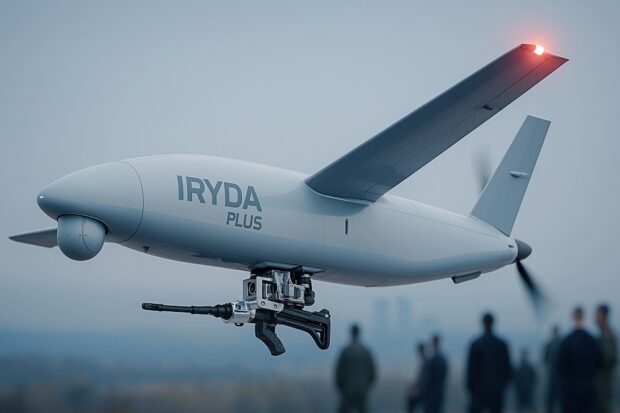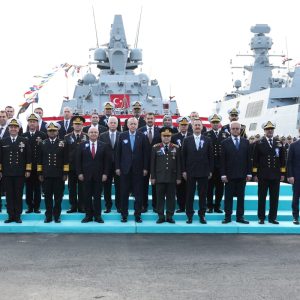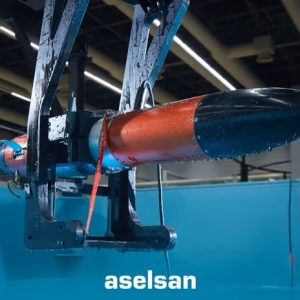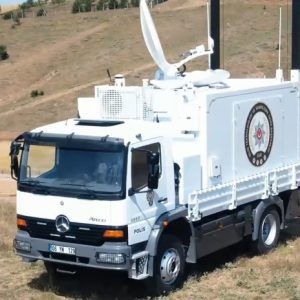
Poland has unveiled the IRYDA Plus unmanned counter-drone fighter—a pilotless interceptor positioned to tackle mini‑UAVs, drone swarms and loitering munitions with hard‑kill effects while slashing the cost‑exchange burden that dogs traditional air defence. A newly formed consortium of MBF Group S.A. (leader), Squadron Sp. z o.o. (ASE Group) and the Polish Industrial Lobby (PLP) launched the programme on 15 September, describing it as Europe’s first unmanned fighter tailored for counter‑UAS missions.
Key Facts — IRYDA Plus
- Role: hard‑kill C‑UAS unmanned fighter; kinetic defeat of drones, swarms and loitering munitions
- Performance (targeted): 250–280 km/h top speed; 180–200 km/h cruise; minimum 50–60 km/h; 8–10 hours endurance
- Payload: 15–20 kg; 7.62 mm carbine in a 360° rotating gondola with AI‑assisted TAS (Target‑Aim‑Shot)
- Programme structure: staged work packages (gun nacelle; control/simulation; mock‑up airframe; transport container)
- Use cases: border and critical‑infrastructure defence, protection of C2 nodes, and expeditionary missions
Why this matters: fixing the cost‑exchange problem
Drones have redrawn the air‑defence map. Low‑cost quadcopters and attritable fixed‑wing drones now probe gaps, hunt artillery, and saturate short‑range systems. In response, many militaries still fire missiles worth six or seven figures to defeat targets that cost a few thousand dollars. The IRYDA Plus unmanned counter-drone fighter attacks that asymmetry directly: a gun‑armed airframe with long endurance, high dash speed, and enough agility to chase, close and kill without expending precious interceptors.
Classing IRYDA Plus as a “fighter” is a calculated statement. It signals a move from static C‑UAS stacks to maneuvering air defence—paired with AI‑assisted fire control—to restore favourable economics when adversaries scale swarms. As a working theory, this concept borrows the logic of WWII fighter sweeps and applies it to today’s drone‑dense skies: persistent patrol, rapid vectoring, and repeated engagements during a single sortie.
What the consortium is building
The consortium’s baseline architecture revolves around a modular rotating gun gondola under a fixed‑wing airframe, an operator station, and a TAS (Target‑Aim‑Shot) loop accelerated by computer vision and onboard AI. Claimed performance targets include a 250–280 km/h chase speed, 8–10 hours on station, and a 15–20 kg mission payload—parameters that, if achieved, would enable both patrol and pursuit profiles while keeping unit and through‑life costs under control.
Early work packages (WP1–WP4) progress from a functional gun nacelle through to systems integration and a full mock‑up airframe. Digitally, the team plans to war‑game three combat scenarios to tune engagement logic before live trials. This stepwise approach aligns with European certification realities, while letting the group show tangible milestones that unlock the next tranche of funding.
TAS/AI and a return to gun‑based air policing
Why a 7.62 mm carbine and not a missile pod? Because bullets are absurdly cheap per engagement, and the debris footprint is predictable at short ranges. A stabilized, 360° gondola plus AI‑based lead‑angle calculation can deliver high closure‑rate shots against multicopters and small fixed‑wing drones, especially when the shooter itself maneuvers. The trade‑offs are real—ballistic dispersion, limited effective range, and deconfliction—but the promise is multiple kills per sortie without touching high‑end missile inventory. It is, unapologetically, an engineer’s answer to a budget problem.
Where could IRYDA Plus fit in Europe’s C‑UAS stack?
Poland’s pitch lands in a crowded but fragmented counter‑drone market. Soft‑kill jammers struggle against autonomous navigation; surface guns and missiles are effective but expensive and cueing‑limited; airborne interceptors exist, yet most are either net‑guns or bespoke intercept‑drones with short endurance. By contrast, the IRYDA Plus unmanned counter-drone fighter aims to combine persistence with hard‑kill flexibility—patrolling borders, shielding infrastructure, and sweeping drone‑assembly points beyond the wire.
If it reaches maturity, the platform could augment ground‑based SHORAD by engaging pop‑up threats in the gap between electronic attack and missile shots. It could also escort high‑value convoys and defend temporary command posts where setting up full C‑UAS stacks is impractical.
Industrial logic and governance
This is not a garage project. MBF Group—publicly listed on Warsaw’s NewConnect—leads capital formation and investor relations, bringing market transparency and mandatory disclosures. Squadron (ASE Group) supplies UAS engineering talent with Polish Armed Forces pedigree, handling demonstrators and systems integration. PLP provides policy reach and convening power across academia and industry. Together they offer a blend of capital + engineering + policy that is unusually well‑rounded for an early‑stage C‑UAS platform.
Critically, the consortium emphasizes a staged roadmap with reportable milestones, regulatory filings and a push for export markets from the outset. That governance posture matters when courting European customers who must integrate sovereignty, safety and supply‑chain assurances into procurement.
Caveats and open questions
The claim of being “Europe’s first” unmanned fighter designed explicitly for counter‑drone missions is the consortium’s characterization, not a settled taxonomy. Europe has airborne C‑UAS efforts—from recoverable interceptors to net‑gun drones—but few gun‑armed, long‑endurance “fighter” concepts built to patrol and prosecute multiple targets in one sortie. Two technical questions will decide viability:
- Fire control fidelity: Can the TAS/AI loop produce consistent, ethically and legally compliant hit probabilities without unacceptable collateral risk?
- Airframe economics: Can the system meet its 8–10 hour endurance and 250–280 km/h chase speed within a price point that undercuts missile shots and reduces O\&S costs?
Answering both requires rigorous simulation, tightly instrumented trials, and integration into a layered C2 picture so the aircraft is cued efficiently and deconflicted with friendly traffic.
Strategic context: Europe’s swarm era
From Ukraine to the Red Sea, swarming behaviors and cheap kamikaze drones are eroding the deterrent value of exquisite air‑defence inventory. NATO’s doctrine now frames counter‑UAS as integral to integrated air and missile defence, pushing Allies to experiment with mobile, multi‑layered kill‑chains. In that context, a IRYDA Plus unmanned counter-drone fighter is not a curiosity; it is an attempt to restore initiative with a maneuvering, attritable effector that scales.
For Poland, the bet also aligns with domestic industrial policy—creating a sovereign C‑UAS product line with export potential and a testbed for AI‑enabled fire control, training simulators and digital‑twin development.
Programme timeline and next steps
The team showcased the concept at MSPO Kielce (2023 and 2024), reported new cooperation agreements in early September 2025, and formally launched the programme on 15 September. Near‑term milestones include a full gun‑nacelle demonstrator, closed‑loop simulation in three engagement scenarios, and a mock‑up airframe installation ahead of field evaluations. Success here would justify scaling into a flight‑worthy prototype and, eventually, a producible patrol‑and‑pursuit variant tailored for border guards and air‑defence brigades.
Internal coverage
- Related analysis: FPV rocket‑propelled drone interceptor experiments — our deep‑dive on tube‑launched FPV concepts.
- NATO’s robot navy push: REPMUS/Dynamic Messenger 2025 — unmanned integration at sea and what it means for C‑UAS doctrine.
References
- UAS Vision. “Three Polish Partners Join to Build Unmanned Counter‑Drone Aircraft.” 19 Sep 2025. Available at: uasvision.com
- MBF Group S.A. “IRYDA Plus: A new dimension in drone defense.” 15 Sep 2025. Available at: mbfgroup.pl
- National Defense Magazine. “Polish Partners Set Out to Build Uncrewed Counter‑Drone Fighter.” 17 Sep 2025. Available at: nationaldefensemagazine.org
- Parkiet / ESPI regulatory filing. “MBF Group S.A.: Uruchomienie projektu IRYDA Plus…” 15 Sep 2025. Available at: parkiet.com
- PAP Biznes. “Konsorcjum MBF Group, Squadron i PLP uruchomiło projekt IRYDA.” 15 Sep 2025. Available at: biznes.pap.pl
- NATO IAMD COE. “Countering Unmanned Aerial Systems (C‑UAS).” Accessed Sep 2025. Available at: iamd-coe.org
Further Reading: Russian FPV rocket‑drone interceptor trials; China’s LY‑1 laser air defence; NATO’s REPMUS/Dynamic Messenger 2025











